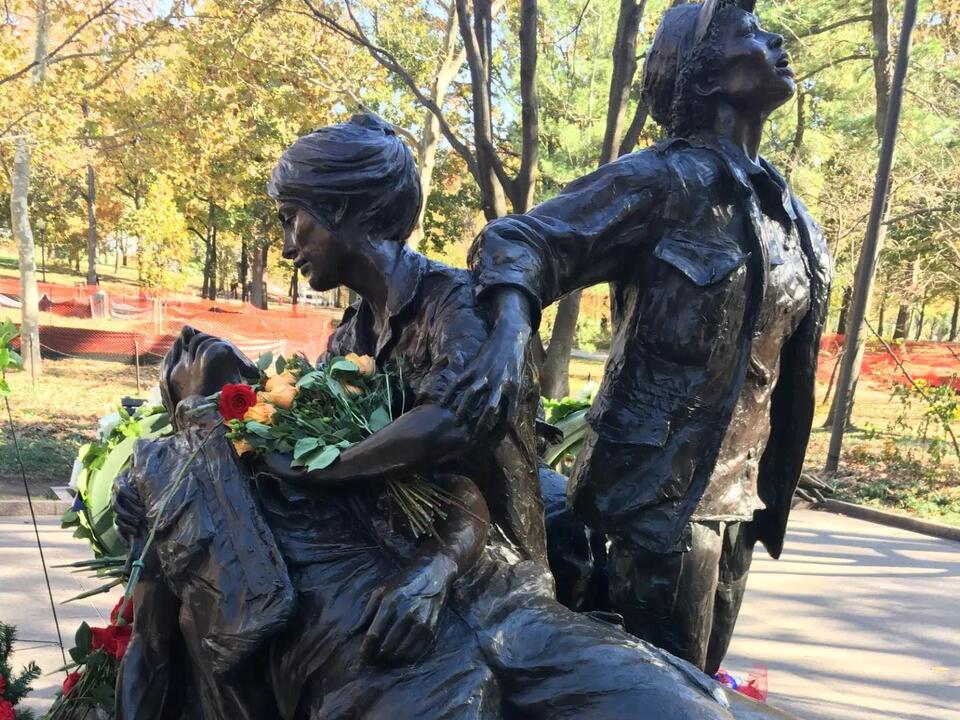Physical Address
304 North Cardinal St.
Dorchester Center, MA 02124
Physical Address
304 North Cardinal St.
Dorchester Center, MA 02124

I vividly remember the emotions that coursed through my body the first time I saw the Vietnam Women’s Memorial on the National Mall in Washington, D.C. The sculpture depicts three uniformed women holding a wounded soldier. It is a dramatic representation of the sacrifice, commitment, and compassion of the women who served, primarily the courageous nurses. As I walked around the sculpture slowly, studying every detail, memories long stored beneath a tough shell broke free and took me to a place I did not want to go.
Kristan Hannah’s novel, The Women, affected me the same way. My wife and her many book-reading pals had suggested I read Hannah’s book. Among them was our friend Sally Robinson who wanted to know if the book was an accurate reflection of my Vietnam experience. But it was my friend, Butch Adams, who convinced me to read it. I am glad he did.
I confess I had to put it down after the first five chapters. The vivid and accurate descriptions of the sounds, the smells, the overwhelming heat, and the filth of a forward fire base in Vietnam were initially more than I could handle. But I picked it up again and loved it.
There are some inaccuracies and some descriptions of how America prosecuted the war that seem politically influenced to me. Among the untruths is a statement in Chapter Twelve that young men were being shipped to Vietnam with just six weeks of basic training. This is untrue. Army and Marine basic training lasted eight weeks in 1967 as today. This was followed by advanced infantry training for another eight weeks. Following months of instruction and field exercises, recruits were assigned to U.S.-based units for further grooming in all aspects of combat. I joined the Army in November 1966 and spent 10 months of training before a nine-month assignment to the 82nd Artillery at Fort Bragg for field operations before shipping out to Vietnam in August 1968. I was not the exception to the rule. No American combat soldier or Marine was sent to Vietnam with just six weeks training.
Hannah also says most American combatants in Vietnam were African American and Hispanic. This is untrue. The overwhelming majority of those who served in the war were young white men. The demographics were 88% Caucasian, 10% black, and the rest “other.” This was long before the huge influx of Hispanic soldiers who now serve in the U.S. military branches with honor, competence, and courage. The racial breakdown of those killed is nearly identical to that of those who served, overwhelmingly white men. Of the 58,267 people killed in Vietnam, the names of eight women, all nurses, are carved into the black granite of the Vietnam Memorial.
The book states there were many American atrocities committed on the villagers of rural Vietnam, including intentional napalm strikes. In my year in the country, I experienced nothing approaching violence toward innocent civilians, not by Americans. But I served with professional officers and NCOs. Atrocities are a breakdown in command and unit discipline. As a field artillery forward observer, one of my jobs was to coordinate aerial bombing and strafing missions, including napalm strikes. I never saw indiscriminate, or even accidental bombing of civilian populations. But the Vietcong were little different from Hamas. They hid among civilians. They used women and children as human shields. They had no regard for human life, and they committed countless acts of brutality and genocide against unarmed men, women, and children. The poor villagers were often caught in the middle of firefights, but our men did all they could to protect noncombatants, often risking their lives to keep them as safe as possible.
All of this said, the book is great. The writing is exceptional, and the characters, especially combat nurse Frankie McGrath, are compelling and strong. The story is touching. Hannah captures the unique emotions of combat; the guilt when courage and skill falter; the heart-shattering grief when men you know, and love are lost; the indescribable fatigue; the unanticipated disappointment in coming back to the life you left but no longer know or even want.
The book, like most bestsellers, is a love story. Love breaks us. Love puts us back together. Frankie’s heart was broken again and again, but it was the people she loved and who loved her who saved her each time. In the end, she found purpose and happiness saving others like her who were tormented by their wartime experience.
I returned from combat in Vietnam to a wife who loved me, a little girl who soon became my best buddy, and to family, friends, and faith that healed me. I was among most Vietnam vets who were able to get over the war. Some, like Frankie McGrath, could not. Their experiences are portrayed well in this book. It touched me deeply to read and reflect on their struggles. You should get The Women, and read it. I promise you will love it.
Source: The Gaston Gazette



